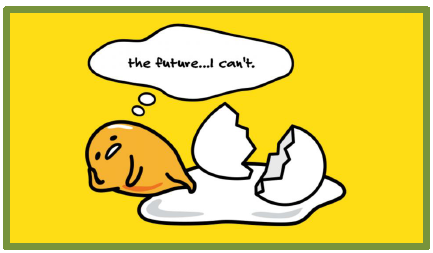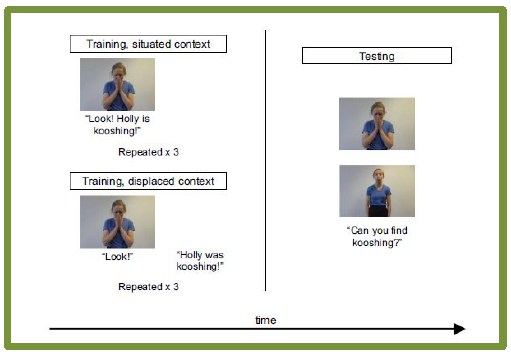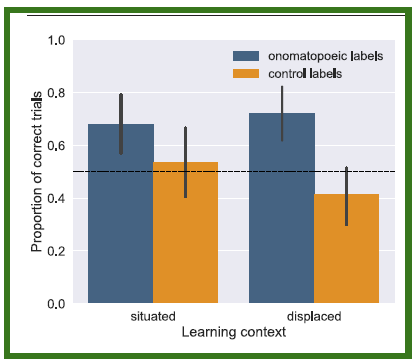Onomatopoeias help kids learn words
By Fiza Ahmad & Evonne Syed
What are onomatopoeias?
When someone says, "The car went zoom", how do you know that they meant it went fast and not slow? Sounds such as zoom, thud, and squeak are called onomatopoeia(s) [on-nuh-ma-to-pee-uh(z)]. These are words that sound like the noises we talk about. For example, if a child dropped an egg and it made a splat noise, the child might tell their mom that "The egg went splat". These onomatopoeias are a good way for kids to describe what they mean. For a child, saying "the egg went splat", might be easier than saying "it broke and made a mess". Kids are still learning words, so these onomatopoeias give them a great way to explain what they hear and see around them. This is why onomatopoeias might tell us about how kids learn what words mean. Researchers tested this idea in a scientific experiment.

Understanding how onomatopoeias are used
Kids use words to copy the noises they hear around them. This way they learn that speech sounds have meaning and can describe objects or actions in the world. This skill can be used even if the object or action is not seen in front of them. In the egg example from earlier, the mom might not see the egg break before her child tells her it went splat. But, she can still picture in her head that the egg broke and made a mess. This use of onomatopoeias helps prepare kids to grow their vocabulary in early childhood.
Did you know that onomatopoeias exist in many languages? In fact, these silly words are used by people all over the world- especially children! The researchers of this experiment think that children learn onomatopoeias faster than they learn other words. This is because, as we discussed earlier, these words are easier for children to understand. They also think that onomatopoeias are a good way to grab children's attention, which also helps them learn more. This is why parents and grown-ups should use onomatopoeias during a child's early years. However, as the child grows up, their vocabulary and understanding of the world will also increase, so onomatopoeias become less important. Researchers predict that children can picture the meaning of onomatopoeias in their heads even when the action related to the noise cannot be seen in front of them. The researchers did an experiment to test these predictions. They wanted to investigate the relationship between onomatopoeias and word learning, both when the action can be seen by the kids or cannot be seen by them.
How was this done?

Researchers gathered data from 37 children that were 2-3 years old. They tested whether they learned onomatopoeic words more easily than non-onomatopoeic words. Researchers made a list of fake onomatopoeias for already existing words. For example, "sneezing" was given the new label of "kooshing". These labels could be related or unrelated to the original word. The unrelated labels were used as a comparison (control). Children learned the new word labels either while seeing the action in front of them (which we call 'situated'), or not seeing the action in front of them (which we call 'displaced'). After, they were tested on if they could remember these fake onomatopoeias.
What did they see?
The experiment showed that the onomatopoeic labels were learned much better than the non-onomatopoeic labels. In fact, children found it hard to learn the nononomatopoeic labels. However, there was no evidence that children learned either onomatopoeic or non-onomatopoeic labels differently. This was the case whether they saw the action in front of them (situated) or not (displaced).

The Big Picture
One obstacle faced in this experiment is that it can be hard to tell the difference between actual learning and just being extra aware of onomatopoeic words. However, researchers have concluded that it is actually easier to learn onomatopoeic words.
The results from the experiment show that grown-ups often use onomatopoeias when speaking to children. The ways they use them can also help children's word learning. But, the exact role that onomatopoeias play in learning is harder to determine. Most language learning research focuses on when the object or action can be seen along with words (situated). But, researchers suggest that more research is needed to understand how children learn onomatopoeias when they cannot see the object or action in front of them (displaced).
Even though people have thought of the onomatopoeia as a less important part of language, these results suggest that it can still help grow vocabulary. Onomatopoeias are mainly used in learning a first language, but what we learned from this experiment could also help us understand how language has changed over time. We make connections between onomatopoeic words and what we see, hear, and experience. This can explain why adults continue to use onomatopoeias in their language over time. This is because onomatopoeias may play a key role in how human languages are invented, learned, and changed by their users. So, feel free to make sounds out of what you hear and see around you! Not only does it make things more fun, but now you've learned that it can be helpful for word learning too!
Glossary
Onomatopoeia: Words that sound like the noises we talk about. (e.g. Zap, Oink)
Experiment: A scientific way to test an idea and make discoveries.
Control: A group added to an experiment that does not include the idea we want to test. It acts as a comparison with the thing that we do want to test (e.g. if we want to test onomatopoeic words, the control would be non-onomatopoeic words).
Situated: When the object or action related to what is said can be seen.
Displaced: When the object or action related to what is said cannot be seen.
First language: The first language a person learns and knows best.
Non-onomatopoeic Words: Words that don't sound like the noises we talk about.
References
- Motamedi, Y., Murgiano, M., Perniss, P., Wonnacott, E., Marshall, C., Goldin‐Meadow, S., & Vigliocco, G. (2020). Linking language to sensory experience: Onomatopoeia in early language development. Developmental Science. https://doi.org/10.1111/desc.13066
- Winn, P. (2016) One of Japan's most popular mascots is an egg with crippling depression. The World. https://www.pri.org/stories/2016-07-31/one-japan-s-mostpopular-mascots-egg-crippling-depression
